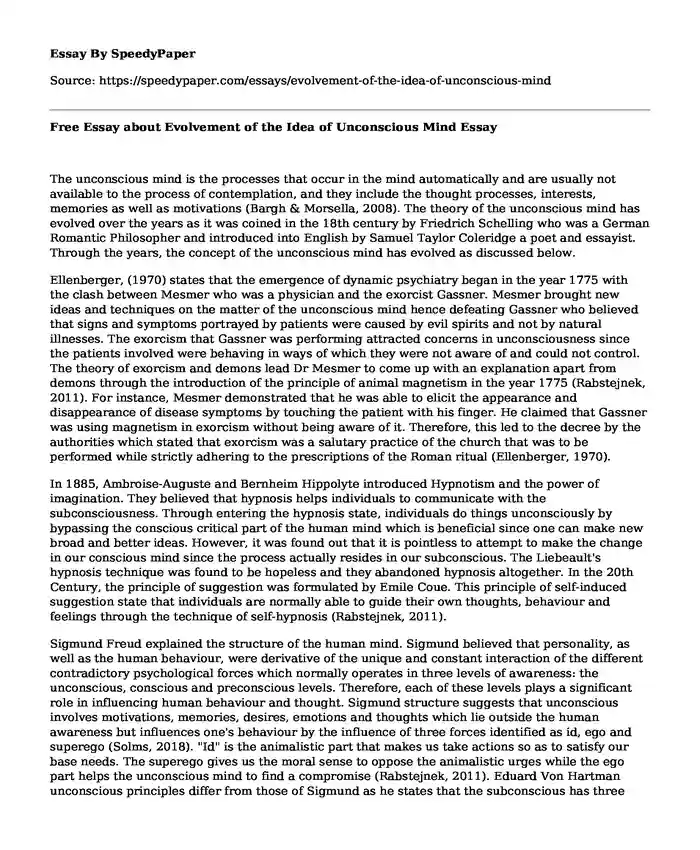
| Type of paper: | Essay |
| Categories: | Philosophy |
| Pages: | 3 |
| Wordcount: | 770 words |
The unconscious mind is the processes that occur in the mind automatically and are usually not available to the process of contemplation, and they include the thought processes, interests, memories as well as motivations (Bargh & Morsella, 2008). The theory of the unconscious mind has evolved over the years as it was coined in the 18th century by Friedrich Schelling who was a German Romantic Philosopher and introduced into English by Samuel Taylor Coleridge a poet and essayist. Through the years, the concept of the unconscious mind has evolved as discussed below.
Ellenberger, (1970) states that the emergence of dynamic psychiatry began in the year 1775 with the clash between Mesmer who was a physician and the exorcist Gassner. Mesmer brought new ideas and techniques on the matter of the unconscious mind hence defeating Gassner who believed that signs and symptoms portrayed by patients were caused by evil spirits and not by natural illnesses. The exorcism that Gassner was performing attracted concerns in unconsciousness since the patients involved were behaving in ways of which they were not aware of and could not control. The theory of exorcism and demons lead Dr Mesmer to come up with an explanation apart from demons through the introduction of the principle of animal magnetism in the year 1775 (Rabstejnek, 2011). For instance, Mesmer demonstrated that he was able to elicit the appearance and disappearance of disease symptoms by touching the patient with his finger. He claimed that Gassner was using magnetism in exorcism without being aware of it. Therefore, this led to the decree by the authorities which stated that exorcism was a salutary practice of the church that was to be performed while strictly adhering to the prescriptions of the Roman ritual (Ellenberger, 1970).
In 1885, Ambroise-Auguste and Bernheim Hippolyte introduced Hypnotism and the power of imagination. They believed that hypnosis helps individuals to communicate with the subconsciousness. Through entering the hypnosis state, individuals do things unconsciously by bypassing the conscious critical part of the human mind which is beneficial since one can make new broad and better ideas. However, it was found out that it is pointless to attempt to make the change in our conscious mind since the process actually resides in our subconscious. The Liebeault's hypnosis technique was found to be hopeless and they abandoned hypnosis altogether. In the 20th Century, the principle of suggestion was formulated by Emile Coue. This principle of self-induced suggestion state that individuals are normally able to guide their own thoughts, behaviour and feelings through the technique of self-hypnosis (Rabstejnek, 2011).
Sigmund Freud explained the structure of the human mind. Sigmund believed that personality, as well as the human behaviour, were derivative of the unique and constant interaction of the different contradictory psychological forces which normally operates in three levels of awareness: the unconscious, conscious and preconscious levels. Therefore, each of these levels plays a significant role in influencing human behaviour and thought. Sigmund structure suggests that unconscious involves motivations, memories, desires, emotions and thoughts which lie outside the human awareness but influences one's behaviour by the influence of three forces identified as id, ego and superego (Solms, 2018). "Id" is the animalistic part that makes us take actions so as to satisfy our base needs. The superego gives us the moral sense to oppose the animalistic urges while the ego part helps the unconscious mind to find a compromise (Rabstejnek, 2011). Eduard Von Hartman unconscious principles differ from those of Sigmund as he states that the subconscious has three levels but different from those of Sigmund: absolute unconscious, physiological and relative unconscious. Sullowy introduced the Multiple facets of psychoanalytic theory that puts controversies on the works of Sigmund.
Timeline
18th century - Friedrich Schelling coined the term.
18th century - Samuel Taylor Coleridge introduced the term into English.
1774 - Gassner introduced the concept of exorcism and demons.
1775 - The Clash between Gassner and Mesmer hence introducing new techniques and ideas
1775 - Mesmer introduced the principle of animal magnetism.
1885 - Ambroise-Auguste and Bernheim Hippolyte introduced Hypnotism.
20th Century - The principle of suggestion was formulated by Emile Coue.
1939- Sigmund Freud explains the structure of the human mind.
1972 - Eduard Von Hartman introduced absolute, physiological and relative unconscious.
1979 - Sullowy introduced the Multiple facets of psychoanalytic theory.
References
Bargh, J. A., & Morsella, E. (2008). The unconscious mind. Perspectives on psychological science, 3(1), 73-79.
Ellenberger, H. F. (1970). The discovery of the unconscious: The history and evolution of dynamic psychiatry (Vol. 1, pp. 280-281). New York: Basic Books.
Rabstejnek, C. V. (2011). History and evolution of the unconscious before and after Sigmund Freud. Psychology, 22(4), 524-543.
Solms, M. (2018). Do unconscious phantasies really exist? 1. In Unconscious phantasy (pp. 89-105). Routledge.
Cite this page
Free Essay about Evolvement of the Idea of Unconscious Mind. (2022, Jul 12). Retrieved from https://speedypaper.com/essays/evolvement-of-the-idea-of-unconscious-mind
Request Removal
If you are the original author of this essay and no longer wish to have it published on the SpeedyPaper website, please click below to request its removal:
- Free Essay on Community-Based Juvenile Corrections Services
- Essay Sample on Ethical Dilemma at Workplace
- Essay Sample on the Difference between Native and Settler Relations to Land
- Essay Sample about Politics in America Today
- Free Essay on the Environmental Impact of the Samsung Company
- Free Essay Example: Obesity Among the Children
- Essay Example on Canada Political Scandal
Popular categories




